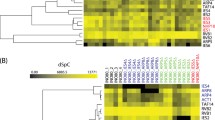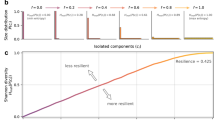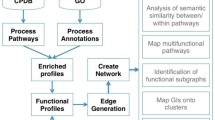The most highly connected proteins in the cell are the most important for its survival.
Abstract
Proteins are traditionally identified on the basis of their individual actions as catalysts, signalling molecules, or building blocks in cells and microorganisms. But our post-genomic view is expanding the protein's role into an element in a network of protein–protein interactions as well, in which it has a contextual or cellular function within functional modules1,2. Here we provide quantitative support for this idea by demonstrating that the phenotypic consequence of a single gene deletion in the yeast Saccharomyces cerevisiae is affected to a large extent by the topological position of its protein product in the complex hierarchical web of molecular interactions.

Similar content being viewed by others
References
Hartwell, L. H., Hopfield, J. J., Leibler, S. & Murray, A. W. Nature 402, 47–52 (1999).
Eisenberg, D., Marcotte, E. M., Xenarios, I. & Yeates, T. O. Nature 405, 823–826 (2000).
Uetz, P. et al. Nature 403, 623–627 (2000).
Xenarios, I. et al. Nucleic Acids Res. 28, 289–291 (2000).
Jeong, H., Tombor, B., Albert, R., Oltvai, Z. N. & Barabási, A.-L Nature 407, 651–654 (2000).
Amaral, L. A., Scala, A., Barthelemy, M. & Stanley, H. E. Proc. Natl Acad. Sci. USA 97, 11149–11152 (2000).
Rain, J.-C et al. Nature 409, 211–215 (2001).
Albert, R., Jeong, H. & Barabási, A.-L Nature 406, 378–382 (2000).
Winzeler, E. A. et al. Science 285, 901–906 (1999).
Ross-Macdonald, P. et al. Nature 402, 413–418 (1999).
Fell, D. A. & Wagner, A. in Animating the Cellular Map (eds Hofmeyr, J.-H, Rohwer, J. M. & Snoep, J. L.) 79–85 (Stellenbosch Univ. Press, 2000).
Wagner, A. Nature Genet. 24, 355–361 (2000).
Costanzo, M. C. et al. Nucleic Acids Res. 28, 73–76 (2000).
Author information
Authors and Affiliations
Corresponding authors
Rights and permissions
About this article
Cite this article
Jeong, H., Mason, S., Barabási, AL. et al. Lethality and centrality in protein networks. Nature 411, 41–42 (2001). https://doi.org/10.1038/35075138
Issue Date:
DOI: https://doi.org/10.1038/35075138
- Springer Nature Limited
This article is cited by
-
ECDEP: identifying essential proteins based on evolutionary community discovery and subcellular localization
BMC Genomics (2024)
-
DomiRank Centrality reveals structural fragility of complex networks via node dominance
Nature Communications (2024)
-
Hyper-distance oracles in hypergraphs
The VLDB Journal (2024)
-
Revisiting neighbourhood proximity based algorithm for overlapping community detection in weighted networks
Social Network Analysis and Mining (2024)
-
Integrated bioinformatics analysis for the identification of idiopathic pulmonary fibrosis–related genes and potential therapeutic drugs
BMC Pulmonary Medicine (2023)





